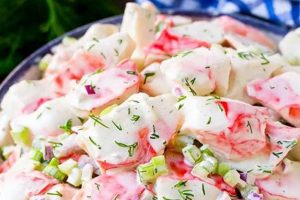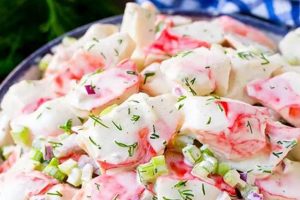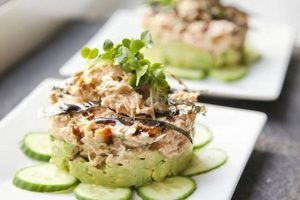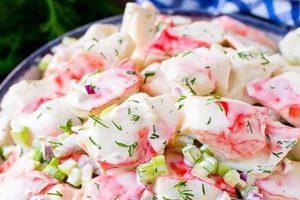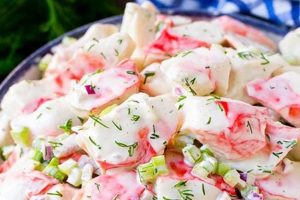A guide to preparing a dish mimicking the flavor and texture of crab salad, typically using surimi, a processed fish product, offers a cost-effective and convenient alternative to traditional crab meat. Such guides often incorporate ingredients like mayonnaise, celery, onion, and seasonings to recreate the classic crab salad experience.
The accessibility and versatility of surimi-based alternatives have broadened culinary possibilities, allowing for a wider range of individuals to enjoy crab-like flavors. This approach offers a sustainable option for those seeking to reduce their environmental impact while still enjoying familiar tastes. Historically, the development of surimi provided a solution to utilizing readily available and affordable fish species, contributing to a more diverse and efficient food system.
This discussion will further explore variations on this dish, including ingredient substitutions, preparation techniques, and serving suggestions to enhance culinary creativity and enjoyment.
Tips for Preparing Surimi Salad
Optimizing the preparation of surimi salad involves careful consideration of ingredient selection and technique. The following tips offer guidance for achieving desirable flavor and texture.
Tip 1: Quality Surimi Selection: Opting for higher-quality surimi contributes significantly to the final dish. Look for products with a firm texture and a mild, fresh aroma.
Tip 2: Thorough Draining: Excess moisture in the surimi can dilute the flavor and create a watery salad. Pressing the surimi gently with paper towels before mixing helps achieve optimal consistency.
Tip 3: Balanced Seasoning: While imitation crab offers a subtle flavor, enhancing it with complementary seasonings is crucial. Consider incorporating Old Bay, dill, lemon juice, or paprika.
Tip 4: Fresh Vegetable Incorporation: Finely diced celery and red onion provide textural contrast and enhance the overall flavor profile. Experimenting with other vegetables like bell peppers or water chestnuts can add further complexity.
Tip 5: Binder Selection: Mayonnaise is traditionally used, but Greek yogurt or a combination of both can offer a lighter, tangier alternative.
Tip 6: Chill Time: Allowing the salad to chill for at least 30 minutes before serving allows the flavors to meld and the salad to firm up.
Tip 7: Serving Considerations: Surimi salad can be enjoyed in various ways, from a classic sandwich filling to a lettuce wrap or a topping for crackers.
By following these tips, one can elevate surimi salad from a simple dish to a flavorful and satisfying culinary experience.
These guidelines offer a strong foundation for preparing surimi salad, paving the way for further exploration of individual preferences and creative variations.
1. Ingredients
Ingredient selection significantly impacts the quality and character of a surimi-based salad. The interplay of components determines the final flavor profile, texture, and overall appeal. Surimi, the foundational element, provides the delicate, slightly sweet seafood-like flavor. Its quality directly correlates with the final outcome, influencing both taste and texture. Mayonnaise acts as the binder, contributing creaminess and tang. Its type and quantity affect the salad’s richness and overall moisture content. Fresh vegetables, such as finely diced celery and red onion, offer crucial textural contrast and aromatic complexity. Their freshness and quality influence the vibrancy and overall balance of the salad. Seasonings further enhance the flavor profile, with options like Old Bay, dill, or lemon juice adding depth and complexity. The careful selection and balance of these ingredients are paramount to achieving a successful and enjoyable surimi salad.
For example, using high-quality surimi with a firm texture results in a more substantial and satisfying salad compared to using a softer, less flavorful variety. Similarly, opting for fresh, crisp vegetables contributes a brighter, more appealing flavor and texture compared to using wilted or less flavorful produce. The judicious use of seasonings further enhances the overall experience, creating a well-rounded and balanced flavor profile. Ignoring the quality or balance of these components can result in a bland, watery, or unappetizing salad. Understanding the role and impact of each ingredient empowers informed choices, leading to a more successful culinary outcome.
The careful consideration of ingredients in surimi salad preparation is essential for achieving desired outcomes. This understanding allows for adaptability and customization based on individual preferences and available resources, ensuring a consistently satisfying culinary experience. By recognizing the impact of each component, one can elevate a simple surimi salad from a basic dish to a flavorful and enjoyable culinary creation.
2. Preparation
Preparation techniques significantly influence the final quality and enjoyment of a surimi-based salad. Proper execution of these steps ensures optimal texture, flavor development, and overall appeal. From ingredient handling to mixing and chilling, each stage contributes to the final result.
- Surimi Handling
Gentle handling of surimi prevents it from becoming mushy. Thawing it slowly in the refrigerator and avoiding excessive squeezing during draining preserves its delicate texture. This careful approach ensures the surimi maintains its integrity, contributing to a more pleasant mouthfeel in the finished salad.
- Ingredient Incorporation
The order and method of ingredient incorporation affect the salad’s consistency and flavor distribution. Adding the mayonnaise gradually, after combining the surimi with the vegetables and seasonings, prevents overmixing and ensures even distribution. This methodical approach promotes a balanced flavor profile and prevents the salad from becoming overly saturated with mayonnaise.
- Mixing Technique
Overmixing can lead to a dense, paste-like texture, while undermixing results in uneven flavor distribution. A gentle folding motion, using a spatula or large spoon, ensures all ingredients are combined without compromising the texture of the surimi or vegetables. This delicate approach preserves the integrity of individual components while creating a cohesive and flavorful salad.
- Chilling Period
Chilling allows the flavors to meld and the salad to firm up, enhancing both taste and texture. A minimum of 30 minutes in the refrigerator allows the ingredients to harmonize, creating a more balanced and enjoyable flavor profile. This chilling period also improves the salad’s overall structure, making it easier to handle and serve.
These preparation steps are essential for maximizing the enjoyment of surimi salad. Careful attention to each stage ensures optimal texture, flavor development, and overall presentation. Proper execution of these techniques elevates the dish from a simple mixture to a well-balanced and satisfying culinary experience.
3. Flavor Balance
Flavor balance is paramount in a successful surimi salad recipe. The inherent mildness of surimi necessitates careful consideration of complementary and contrasting flavors. A harmonious blend of savory, sweet, tangy, and salty elements elevates the dish beyond its simple components. An overemphasis on any single flavor can detract from the overall experience, rendering the salad unbalanced and less enjoyable. For instance, excessive mayonnaise can overwhelm the delicate flavor of the surimi, creating a bland, overly creamy texture. Conversely, insufficient acidity can result in a flat, uninteresting taste profile. The interplay of these elements is crucial for a well-rounded and satisfying culinary outcome.
Achieving optimal flavor balance involves understanding the role of each ingredient. The slight sweetness of the surimi pairs well with the tangy notes of mayonnaise, while the crisp freshness of vegetables like celery and red onion offer textural and aromatic contrast. Seasonings like Old Bay, dill, or paprika contribute depth and complexity, further enhancing the overall flavor profile. The quantity of each ingredient is also critical. Too much celery can overpower the delicate surimi flavor, while too little may not provide sufficient textural contrast. Practical experimentation and careful tasting throughout the preparation process allow for adjustments and refinements, ensuring a harmonious balance.
Mastery of flavor balance transforms surimi salad from a basic dish into a nuanced culinary experience. The delicate interplay of ingredients, coupled with precise seasoning, creates a symphony of flavors that complement and enhance one another. This understanding empowers culinary exploration, allowing for customization and adaptation based on individual preferences. The ability to achieve this delicate balance is a key marker of culinary skill and a significant contributor to the overall enjoyment of the dish.
4. Serving Suggestions
Serving suggestions enhance the versatility and enjoyment of a surimi-based salad, extending its potential beyond a standalone dish. Consideration of presentation and complementary elements elevates the dining experience, showcasing the salad’s adaptability and appeal.
- Classic Applications
Traditional uses such as sandwich fillings or lettuce wraps provide familiar and convenient options. These established methods offer a comfortable entry point for those new to surimi salad, highlighting its ability to substitute for traditional crab in familiar contexts. A croissant sandwich filled with surimi salad offers a flaky, buttery counterpoint to the creamy filling, while lettuce wraps provide a lighter, refreshing alternative.
- Elevated Presentations
Serving the salad as a canape topping or an accompaniment to a composed salad elevates its presentation. These approaches demonstrate the salad’s versatility and potential for more refined culinary applications. Surimi salad served on endive leaves with a sprinkle of paprika offers a visually appealing and flavorful appetizer, while incorporating it into a larger salad with mixed greens, tomatoes, and cucumbers adds a protein-rich element and a unique flavor dimension.
- Accompaniments
Pairing surimi salad with complementary sides enhances the overall meal. Considerations include flavor and texture profiles. Serving the salad alongside crusty bread or crackers provides a textural counterpoint, while a side of fresh fruit offers a refreshing contrast to the richness of the mayonnaise. A light vinaigrette dressed green salad offers a refreshing counterpoint.
- Creative Adaptations
Utilizing surimi salad as a filling for deviled eggs or avocados provides a creative twist on classic dishes. These innovative approaches demonstrate the salad’s adaptability and potential for culinary experimentation. Stuffed avocados offer a visually appealing and satisfying appetizer or light meal, while surimi-filled deviled eggs provide a unique and flavorful twist on a traditional party favorite.
Thoughtful serving suggestions elevate surimi salad from a simple dish to a versatile culinary component. Exploring various presentations and accompaniments enhances its appeal and broadens its culinary potential. The adaptability of this dish allows for customization and integration into a wide range of meal options, showcasing its value and versatility in diverse culinary contexts.
5. Variations
Variations within surimi salad recipes demonstrate the adaptability of this dish and its potential to cater to diverse palates and dietary preferences. The core recipe, comprising surimi, mayonnaise, and seasonings, serves as a foundation upon which numerous modifications can be built. These variations often involve ingredient substitutions, additions, or adjustments to the preparation method, resulting in a wide spectrum of flavor profiles and textural experiences. This inherent flexibility contributes to the enduring popularity of surimi salad, allowing for customization based on individual tastes and available resources.
For example, incorporating ingredients like diced bell peppers, water chestnuts, or chopped apples introduces textural complexity and nuanced flavors. Substituting Greek yogurt for a portion of the mayonnaise creates a lighter, tangier alternative, while the addition of spices such as curry powder or smoked paprika introduces distinct flavor profiles. Customization extends beyond ingredients to encompass preparation methods. Instead of a traditional creamy salad, the surimi can be flaked and combined with a vinaigrette for a lighter, more refreshing take. These examples illustrate the versatility of surimi salad and the potential for creative exploration within the basic framework.
Understanding the potential for variation within surimi salad recipes empowers culinary creativity and adaptability. This knowledge allows individuals to tailor the dish to specific dietary needs, such as reducing fat content by using Greek yogurt, or catering to specific flavor preferences by incorporating preferred spices or vegetables. The ability to adapt and modify the core recipe ensures its continued relevance and enjoyment across a broad range of culinary contexts. Further exploration of these variations can lead to the discovery of novel flavor combinations and personalized versions of this versatile dish.
Frequently Asked Questions
This section addresses common inquiries regarding surimi salad, providing concise and informative responses to clarify potential uncertainties and enhance understanding of this versatile dish.
Question 1: What is the primary ingredient in surimi salad?
Surimi, a processed fish product often made from pollock, serves as the foundation of this salad, providing a mild, slightly sweet flavor and a texture reminiscent of crab meat.
Question 2: Is surimi salad a healthy option?
Surimi salad can be a part of a healthy diet, offering a good source of protein. However, its nutritional value varies depending on the specific ingredients used, particularly the type and amount of mayonnaise or other binders. Monitoring portion sizes and opting for lower-fat alternatives, such as Greek yogurt, can contribute to a more balanced nutritional intake.
Question 3: How long can surimi salad be stored?
Properly stored in an airtight container in the refrigerator, surimi salad typically remains safe to consume for three to five days. Indicators of spoilage include a sour smell, discoloration, or a slimy texture. Adhering to safe food handling practices is essential for preventing foodborne illnesses.
Question 4: Can surimi salad be frozen?
Freezing is not generally recommended for surimi salad, as the mayonnaise-based dressing tends to separate and become watery upon thawing, significantly affecting the texture and overall quality of the dish.
Question 5: What are common allergens to be aware of in surimi salad?
Individuals with shellfish allergies should exercise caution, as surimi is a fish product and cross-contamination can occur during processing. Additionally, ingredients like mayonnaise may contain egg or soy, which are also common allergens. Careful review of ingredient labels is crucial for those with specific dietary restrictions or allergies.
Question 6: How can the flavor profile of surimi salad be adjusted?
The inherent mildness of surimi allows for significant flavor customization. Ingredients like Old Bay seasoning, dill, lemon juice, paprika, or sriracha can be added to enhance and personalize the flavor profile. Experimentation with different herbs, spices, and sauces offers a wide range of flavor possibilities, catering to individual preferences.
Understanding the composition, storage, and potential allergens in surimi salad facilitates informed consumption decisions. This knowledge empowers individuals to incorporate this versatile dish into their diets safely and enjoyably.
This concludes the frequently asked questions section. The subsequent sections will delve further into specific recipe variations and advanced preparation techniques.
Conclusion
Exploration of surimi salad recipes reveals a dish offering both convenience and adaptability. From ingredient selection and preparation techniques to flavor balancing and serving suggestions, the potential for customization is significant. Understanding the core components and their interplay allows for culinary creativity, enabling adaptation to diverse palates and dietary preferences. The versatility of this dish extends from classic sandwich fillings to innovative culinary creations, showcasing its adaptability across a range of meal occasions.
Surimi salad’s continued presence in culinary landscapes underscores its enduring appeal. Further exploration of flavor profiles, ingredient combinations, and innovative presentation methods promises to expand its culinary potential. The accessibility and adaptability of surimi salad position it as a relevant and evolving dish within the broader culinary repertoire.

